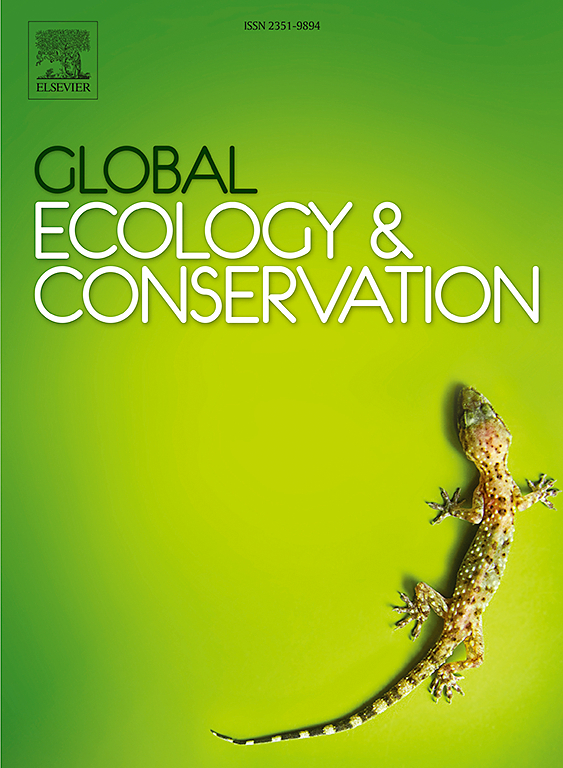Population dynamics of the globally threatened fishing cat (Prionailurus viverrinus) in a coastal anthropogenic landscape of southern Thailand
IF 3.5
2区 环境科学与生态学
Q1 BIODIVERSITY CONSERVATION
引用次数: 0
Abstract
Fishing cat populations are dwindling globally due to habitat loss and conflicts with humans. To address these pressing issues, our study focused on understanding fishing cat dynamics in Khao Sam Roi Yot National Park, a key site in Southeast Asia. Utilizing data from three sampling periods (2019, 2021 and 2023) and over 34,000 camera trap-days, we identified 127 individual adult fishing cats. Our analysis revealed a population density increase from 18 to 24 cats /100 km², from 2019 to 2023, and indicated a positive population growth rate (λ = 1.16). However, spatial survival probabilities were moderate 0.50 (95 % CI 0.33 – 0.67), likely due to isolation and human-caused mortality as suggested by interviews of local people. Despite conservation challenges, the population may be sustaining itself through high rates of recruitment (76 %) and turnover (80 %). Fishing cats exhibited a preference for natural areas with less disturbance within this anthropogenic landscape. This suggests that some relatively urbanized lands could potentially serve as refuge habitats for these felids. The preservation of existing habitats, especially within and near the national park is crucial for their survival, whereas increased law enforcement is unlikely to be an effective approach to achieve sustainable conflict mitigation. Incorporating education about coexistence into local school classrooms and/or community forums, and/or recruiting volunteers to participate in fishing cat monitoring could help reduce conflict over time. We show that understanding the temporal aspects of fishing cat population ecology is essential for their conservation.
泰国南部沿海人为景观中全球濒危渔猫(Prionailurus viverrinus)的种群动态
由于栖息地的丧失和与人类的冲突,全球渔猫数量正在减少。为了解决这些紧迫的问题,我们的研究重点是了解东南亚重要景点考萨姆罗伊尤国家公园的捕鱼猫动态。利用三个采样期(2019年、2021年和2023年)和超过34,000个相机陷阱日的数据,我们确定了127只成年捕鱼猫。分析结果显示,从2019年到2023年,种群密度从18只/100 km²增加到24只/100 km²,种群增长率为正(λ = 1.16)。然而,空间生存概率为中等水平的0.50(95 % CI 0.33 - 0.67),这可能是由于对当地人的采访表明的隔离和人为死亡。尽管面临着保护方面的挑战,但种群可能通过高招募率(76% %)和流动率(80% %)来维持自身。在这种人为景观中,渔猫表现出对干扰较少的自然区域的偏好。这表明一些相对城市化的土地可能成为这些猫科动物的避难栖息地。保护现有栖息地,特别是在国家公园内和附近,对它们的生存至关重要,而加强执法不太可能是实现可持续缓解冲突的有效办法。将关于共存的教育纳入当地学校教室和/或社区论坛,和/或招募志愿者参与渔猫监测,随着时间的推移有助于减少冲突。研究表明,了解渔猫种群生态的时间方面对其保护至关重要。
本文章由计算机程序翻译,如有差异,请以英文原文为准。
求助全文
约1分钟内获得全文
求助全文
来源期刊

Global Ecology and Conservation
Agricultural and Biological Sciences-Ecology, Evolution, Behavior and Systematics
CiteScore
8.10
自引率
5.00%
发文量
346
审稿时长
83 days
期刊介绍:
Global Ecology and Conservation is a peer-reviewed, open-access journal covering all sub-disciplines of ecological and conservation science: from theory to practice, from molecules to ecosystems, from regional to global. The fields covered include: organismal, population, community, and ecosystem ecology; physiological, evolutionary, and behavioral ecology; and conservation science.
 求助内容:
求助内容: 应助结果提醒方式:
应助结果提醒方式:


